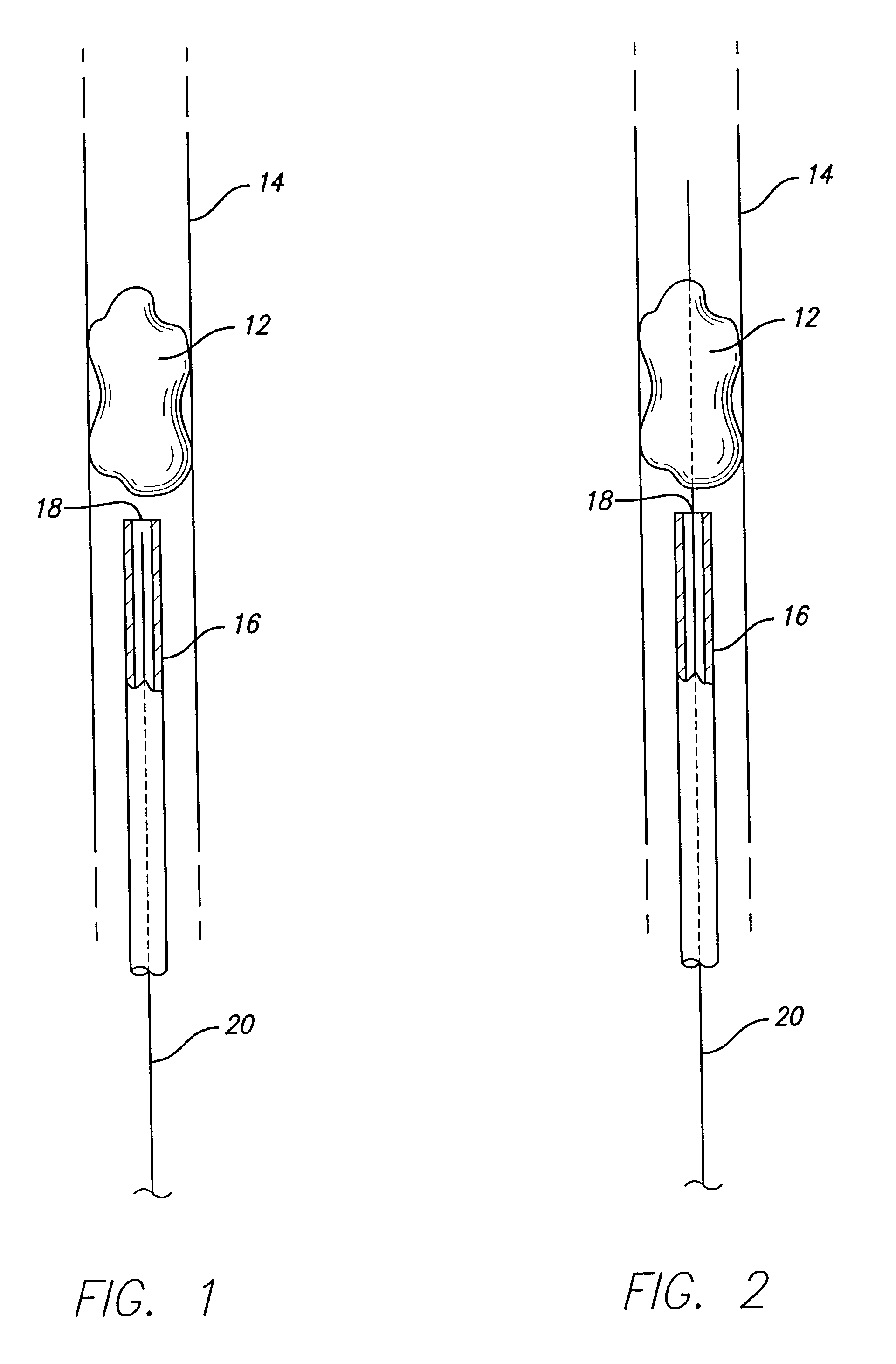Device for removal of thrombus through physiological adhesion
a technology of thrombosis and thrombosis, applied in the field of medical devices, can solve the problems of tissue ischemia (lack of oxygen and nutrients), death, and myocardial infarction, and achieve the effects of restoring native blood flow, improving ability, and quick capture and removal of clots and foreign objects
- Summary
- Abstract
- Description
- Claims
- Application Information
AI Technical Summary
Benefits of technology
Problems solved by technology
Method used
Image
Examples
first embodiment
[0027]In accordance with the present invention, FIGS. 1–4 depict a system for removing thrombus 12 from vessel 14. It is contemplated that the present invention can be used to remove other obstructions or foreign materials from a vessel as well. The present invention is especially useful for trapping and removing thrombi from difficult-to-access distal locations within the highly tortuous cerebral vasculature and neurovasculature.
[0028]The system includes elongate tubular member 16 having a proximal end and a distal end. The elongate tubular member 16 is preferably a microcatheter or other suitable catheter or tubular device for accessing the vasculature, and especially the cerebral vasculature and the neurovasculature. Microcatheters 16 are known in the art and can be constructed from any appropriate biologically compatible material. Typically, microcatheter 16 will have lumen18 and will be constructed from a flexible elastomeric material such as silicone, rubber, polyvinyl chlorid...
second embodiment
[0036]In keeping with the invention, FIG. 5 depicts the present invention wherein catheter 16 is inserted through thrombus 12. The distal end of catheter 16 is positioned just distal to thrombus 12. The insertion of catheter 16 can be accomplished via the use of a guide wire if so desired. A thrombogenic material is then injected out of the distal end of catheter 16. This promotes thrombus growth, wherein the new thrombus 40 adheres to original thrombus 12. The catheter 16 is slowly withdrawn throughout the length of thrombus 12. Thrombogenic material is continually injected out of the distal end of catheter 16 during this process, until catheter 16 has been withdrawn out of the proximal end of thrombus 12. Consequently, thrombus 12 becomes more solid. The thrombus 12 may then be removed from the patient's vasculature by known methods without the risk of traveling emboli posed to the patient.
[0037]Referring to FIGS. 6 and 7, capture devices 30 employing knitted or mesh structures ar...
third embodiment
[0038]Referring to FIG. 6, the present invention embodies a knitted or mesh, hollow basket-like capture device 30 that includes basket 82 attached to wire 21. The basket 82 includes a mesh or knitted portion 86 connected by conventional means such as welding via a plurality of proximally extending arms 88 to the distal end of wire 21. The knitted or mesh portion 86 may form a cone-like configuration with its most distal end 89 defining the apex of the cone. It is to be recognized, however, that other basket configurations may also be employed.
PUM
| Property | Measurement | Unit |
|---|---|---|
| length | aaaaa | aaaaa |
| outer diameter | aaaaa | aaaaa |
| length | aaaaa | aaaaa |
Abstract
Description
Claims
Application Information
 Login to View More
Login to View More - R&D
- Intellectual Property
- Life Sciences
- Materials
- Tech Scout
- Unparalleled Data Quality
- Higher Quality Content
- 60% Fewer Hallucinations
Browse by: Latest US Patents, China's latest patents, Technical Efficacy Thesaurus, Application Domain, Technology Topic, Popular Technical Reports.
© 2025 PatSnap. All rights reserved.Legal|Privacy policy|Modern Slavery Act Transparency Statement|Sitemap|About US| Contact US: help@patsnap.com



